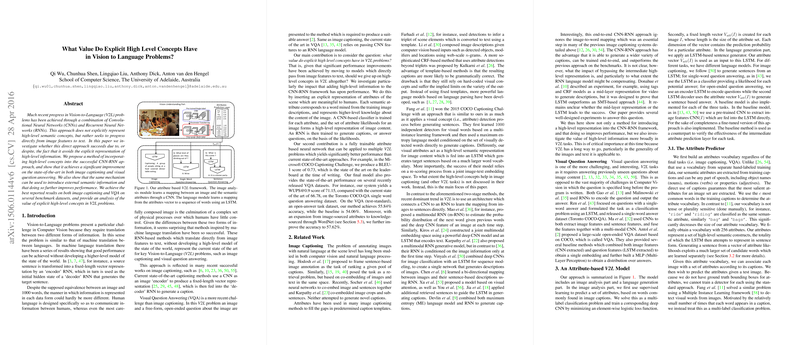An Analysis of Explicit High-Level Concepts in Vision-to-LLMs
This paper discusses the integration of explicit high-level semantic concepts in Vision-to-Language (V2L) models, particularly in the context of image captioning and Visual Question Answering (VQA). The authors challenge the prevalent approach that relies on Convolutional Neural Networks (CNNs) and Recurrent Neural Networks (RNNs), which typically bypasses high-level semantic representation by directly mapping image features to text.
Methodology
The authors propose embedding high-level concepts into the CNN-RNN framework by introducing an attribute-based intermediate layer. This layer predicts semantic attributes from images, which are then used as input to RNNs for generating text. The attribute predictor is trained as a multi-label classification problem, leveraging visual content to derive semantic features.
Key Contributions
- Attribute-Based V2L Model: A fully trainable neural network capable of applying to multiple V2L tasks is introduced. The model predicts semantic attributes using a CNN and utilizes these predictions within an RNN for text generation, showing improved performance over direct CNN-RNN models.
- State-of-the-Art Results: The model demonstrates significant improvements, achieving a BLEU-1 score of 0.73 in the Microsoft COCO Captioning Challenge. The model's efficacy extends to VQA tasks, reaching a [email protected] score of 71.15 on the Toronto COCO-QA dataset and 57.62% accuracy on the VQA dataset, indicating an advancement over existing methodologies.
- Incorporation of External Semantic Information: Beyond image-sourced attributes, the framework successfully integrates knowledge-based attributes from WordNet, further enhancing VQA accuracy. This integration illustrates the importance of external semantic knowledge in complex questioning scenarios.
Numerical Insights
- The proposed model achieves a BLEU-1 score of 0.73, outperforming baseline and several state-of-the-art methods.
- In VQA, substantial accuracy improvements are noted, reaching up to 61.38% on Toronto COCO-QA.
- Knowledge expansion using WordNet uplifts performance, notably on commonsense reasoning questions.
Implications
The findings suggest that explicit high-level concepts confer substantial benefits in V2L tasks, challenging the adequacy of direct feature-to-text mappings. These high-level models provide a framework for incorporating rich semantic knowledge, thereby improving the generalization and depth of V2L solutions.
Future Directions
This research opens avenues for exploring more sophisticated high-level representations that integrate broader semantic or contextual knowledge within AI systems. Further development could focus on enhancing attribute prediction accuracy and extending the knowledge-base linkage to include real-time and dynamic sources.
The exploration of high-level semantic concepts provides a promising frontier for addressing inherent challenges in V2L tasks, advocating for models that emulate human-like understanding and reasoning capabilities. The integration of enriched semantic layers continues to be a focal point in evolving AI research, potentially transforming autonomous interpretation and interaction paradigms.
